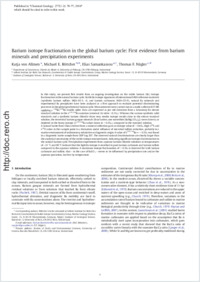Barium isotope fractionation in the global barium cycle: First evidence from barium minerals and precipitation experiments
- Allmen, Katja von Department of Geosciences, University of Fribourg, Switzerland
- Böttcher, Michael E. Leibniz Institute for Baltic Sea Research, Geochemistry & Stable Isotope Geochemistry Group, Marine Geology Section, Warnemünde, Germany
- Samankassou, Elias Department of Geosciences, University of Fribourg, Switzerland
- Nägler, Thomas F. Institute of Geological Science, University of Bern, Switzerland
-
24.07.2010
Published in:
- Chemical Geology. - 2010, vol. 277, no. 1-2, p. 70-77
Global barium cycle
Barium isotope
Diagenetic barite
Barium gangue minerals
Precipitation experiment
English
In this study, we present first results from an ongoing investigation on the stable barium (Ba) isotope fractionation in the natural barium cycle. Stable Ba isotope signatures of international IAEA reference materials (synthetic barium sulfate, IAEA-SO-5, -6, and barium carbonate, IAEA-CO-9), natural Ba minerals and experimental Ba precipitates have been analyzed as a first approach to evaluate potential discriminating processes in the global geochemical barium cycle. Measurements were carried out on a multi-collector ICP-MS applying a ¹³⁰Ba/¹³⁵Ba double spike. Data are expressed as per mil deviation from a laboratory Ba nitrate standard solution in the δ137/134Ba notation (external 2σ stdev < 0.1‰). Whereas the various synthetic solid standards and a synthetic barium chloride show very similar isotope results close to the nitrate standard solution, the terrestrial barium gangue minerals (four barites, one norsethite [BaMg(CO₃)₂]) were close to, or depleted in the heavy isotope (δ137/134Ba values down to −0.2‰), compared to the standard solution.A natural barite from China derived from a mineral collection gave an isotope value of −0.4‰. High δ³⁴S and δ¹⁸O ratios in this sample point to a formation under influence of microbial sulfate reduction, probably in a marine environment of sedimentary exhalative or diagenetic origin. A value of δ137/134Ba = − 0.5‰ was found in a diagenetic barite sample from ODP Leg 207. The observed natural discriminations are clearly larger than the analytical uncertainty of the stable isotope measurements, indicating significant isotope discrimination in the natural barium cycle. Precipitation experiments from aqueous barium chloride solutions at temperatures of ~ 21 °C and 80 °C indicate that the light Ba isotope is enriched in pure barium carbonate and barium sulfate compared to the aqueous solution. A maximum isotope fractionation of − 0.3‰ is observed for both barium carbonate and sulfate, that – in the case of BaCO₃ – seems to be influenced by precipitation rate and/or the aqueous speciation, but less by temperature.
- Faculty
- Faculté des sciences et de médecine
- Department
- Département de Géosciences
- Language
-
- English
- Classification
- Geology
- License
-
License undefined
- Identifiers
-
- RERO DOC 21083
- DOI 10.1016/j.chemgeo.2010.07.011
- Persistent URL
- https://folia.unifr.ch/unifr/documents/301803
Statistics
Document views: 126
File downloads:
- pdf: 528
